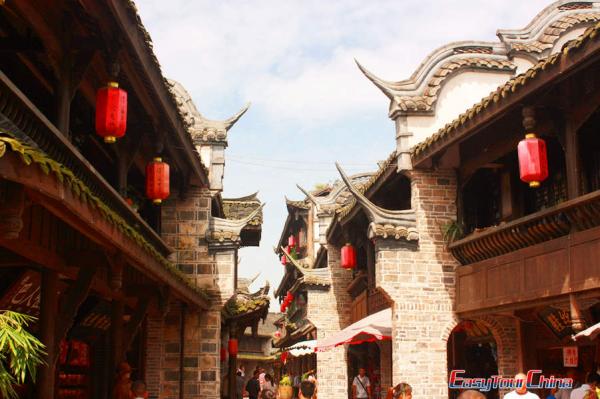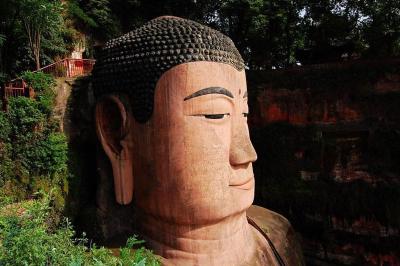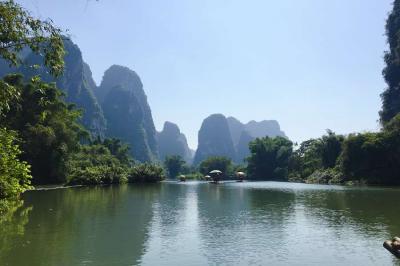Liberation Monument: Jiefangbei Pedestrian Street & Square
Jiefangbei, literally Liberation Monument, stands as one of Chongqing's iconic landmarks. A large pedestrian shopping plaza is centered on the 27.5-meter-high Chongqing People's Liberation Monument, which was built in 1945 to commemorate the victory over the Japanese in WWII. It is not only the symbol of Chongqing's civilization but the evidence of the city's history. Today, Jiefangbei pedestrian street has become synonymous with the central business district, commonly referred to as Jiefangbei CBD.
Prior to the 1990s, Liberation Monument was among Chongqing's tallest structures; now, it is dwarfed by the surrounding forest of skyscrapers.
Liberation Monument Shopping Area is the commercial heart and financial center of Chongqing, and also a symbol of the prosperous Chongqing. As the busiest shopping center in the city, it is popular among local people for the ideal shopping, entertaining and dining facilities, and also a must-visit sight for tourists when traveling in Chongqing.
Chongqing Liberation Monument Facts


The Liberation Monument faces north-east. It is an eight-sided columned dome structure made of reinforced concrete. The total height of the monument is 27.5 meters, with a side length of 2.55 meters. There are eight floors inside, including the underground level.
The interior is circular. There are 140 cantilever spiral stairs, leading directly to the observation deck at the top. At the top of the monument, there are weather instruments such as an anemometer, a wind speed meter, and a compass. Four bells ring automatically in all directions towards the street entrance. Around the monument base is a flower bed.
Beneath the monument are embedded commemorative stones gifted by provinces and municipalities, along with inscribed steles dedicated by prominent figures. The translated text of the scroll presented to Chongqing by U.S. President Roosevelt in 1943 is also engraved on the walls of the Victory Corridor. The Liberation Monument stands as a symbol of the Chinese people's victory in the war against fascism, as well as a symbol of Chongqing's liberation and the city itself.
As Chongqing's “spiritual monument,” Liberation Monument holds profound reverence. Back then, an unwritten rule prevailed in Chongqing—no surrounding buildings could exceed its height. Who broke this precedent? The answer is the 38th Street Department Store, the predecessor of today's Chongqing Department Store Tower standing beside Liberation Monument.
Jiefangbei Pedestrian Street & Square
The Jiefangbei Pedestrian Street transforms the area of 22,400 square meters covering the Liberation Square, Minquan Road, Minzu Road and Zourong Road, centered around Liberation Square, into the Liberation Square Central Shopping Plaza. The roads of the Liberation Pedestrian Street connect the Metropolis Forecourt Plaza, Jiefangbei Square, Women's Shopping Plaza, and Daguoshi Square.Chongqing Jiefangbei CBD
The total area of Chongqing Jiefangbei CBD is 1.61 square kilometers. It consists of the Jiefangbei area and the Chaotianmen area, and serves dual functions of business and trade. The Jiefangbei area extends eastward from Xiaoshizi, northward to Cangbai Road, Linjiang Road, Minsheng Road, westward to Jintang Street, and southward to Heping Road and Xinhua Road. The Chaotianmen area includes 0.69 square kilometers of Chaotianmen area.
Highlights & Top Things to Do in Jiefangbei Pedestrian Street
Hongya Cave
Your Chongqing tour remains incomplete without visiting Hongyadong. Originally named Hongyamen, this historic site was one of Chongqing's ancient city gates. Located on Cangbai Road near Jiefangbei in Yuzhong District, it sits along the riverside where the Yangtze and Jialing rivers converge, and renowned for its traditional Ba-Yu stilted buildings and dazzling nightscape.

Shibati (Eighteen Stairs)
Divided into five sections—A, B, C, D, and E—it features four functional zones: Traditional Culture Experience Area, National Trend Cultural & Creative Experience Area, International Exchange Center, and Lifestyle Center. The area is structured into North-South Scenic Belt and East-West Tourism Expansion Belt, showcasing “Eighteen Scenic Views.” These include two natural landscapes—“Flower Street Bird Song” and “Moonlit Banyan Tree”— seven artistic landscapes like “Spring Breeze at the Ancient Well” and “Viewing the Victory Field,” three historical exhibits such as “Yu Gong's Calligraphy” and the Great Bombing Ruins, and six distinctive operational landscapes including “Fragrant Tea at Xiangshui” and “Baiyu Family.”Yangtze River Cableway
The Yangtze River Cableway connects Xinhua Road in Yuzhong District with Shangxinjie in Nan'an District. It comprises three sections: the Yuzhong Urban History Cultural Zone, the Yangtze River Aerial Sightseeing Zone, and the Nan'an Film and Television Cultural Zone. The cableway spans 1,166 meters with a speed of 6 meters per second, completing a single trip in 4 minutes and 30 seconds. It has a maximum capacity of 65 passengers and handles 10,500 daily riders.Baiyi Road Food Street
Located at No. 174 Baiyi Road within the Jiefangbei Pedestrian Street, it is a paradise for foodies, offering over a hundred varieties of Chongqing food. Sculptures, depicting three girls strolling and an elderly man enjoying Sichuan hot pot created by artists including Xu Guangfu and Yu Zhiqiang adorn the food street. This collection represents Chongqing's earliest urban sculptures installed in a commercial pedestrian zone.Chongqing Huguang Guild Hall
Constructed in the 24th year of the Emperor Qianlong reign (1759) and expanded in the 26th year of the Emperor Daoguang reign (1846), this complex represents Southern architectural artistry from China's Ming and Qing dynasties. It stands as the largest extant ancient guild hall complex in China. Covering 8,561 square meters, it includes the Guangdong Guild Hall, Jiangnan Guild Hall, Lianghu Guild Hall, Jiangxi Guild Hall, and four opera stages, encompassing the Guangdong Public Hall and Qian Public Hall. The guild hall's relief carvings and openwork sculptures are exceptionally exquisite, featuring motifs primarily drawn from the stories of Journey to the West, The Romance of the West Chamber, Investiture of the Gods, and Twenty-Four Filial Exemplars, alongside patterns of dragons, phoenixes, animals, and exotic flora.Chongqing Guotai Art Center
Located at the junction of Linjiang Branch Road, Qingnian Road, and Zou Rong Road in the heart of Chongqing's Jiefangbei CBD, it comprises two venues: the Guotai Grand Theater and the Chongqing Art Museum.
How to Get to Jiefangbei Pedestrian Street and Liberation Monument
There are three ways of getting to the Liberation Monument Commercial Area:
First, take Bus No. 271, 181A, 348, 361, 371, 402, 405, 462, 465, 502 (Air Condition) or 602 and get off at Jiefangbei stop;
Second, take Light Rail Line 2 and get off at Linjiangmen station.
Third, take Chongqing Light Rail Line 1 or Line 6 and get off at Xiaoshizi Station. Walk 500 meters to arrive.


